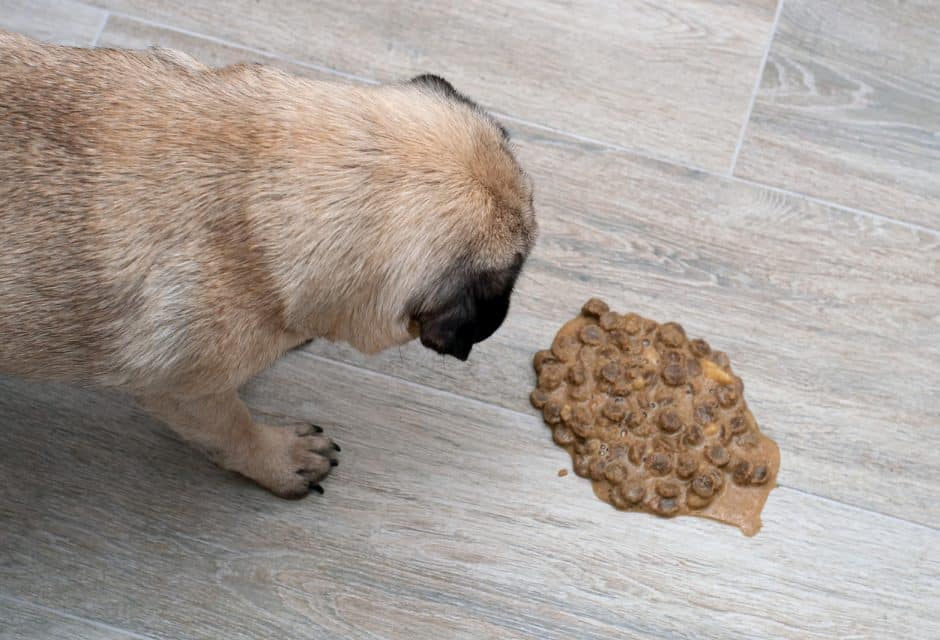

Vomiting and Dogs: Understanding Different Colors and Knowing When to Seek Veterinary Care
Vomiting is a common occurrence in dogs and can be indicative of various underlying health issues. As a responsible pet owner, it's crucial to understand the different colors of vomit and their potential implications. This comprehensive article aims to provide valuable insights into the colors of dog vomit and guide you on when it's necessary to seek veterinary care.
It can be concerning when your dog throws up. Here, we explain when you should seek veterinary care. Vomiting is a common occurrence in dogs and can be indicative of various underlying health issues. As a responsible dog owner, it's crucial to understand the different colours of vomit and their potential implications. This comprehensive article explains the different colours of dog vomit, what they mean, and when it's necessary to seek veterinary care for vomiting.
Why Dogs Vomit
The Mechanism of Vomiting:
Vomiting is the forceful expulsion of stomach contents through the mouth and is the body's protective response to eliminate something harmful. It involves a complex interplay of muscles, nerves, and reflexes.
Identifying Different Colours of Dog Vomit and What They Mean
Clear or Foamy Vomit:
Clear or foamy vomit in dogs is often caused by the accumulation of gastric acid or saliva. This type of vomit is common when a dog's stomach is empty or if they have eaten too quickly. It may also be seen after a bout of intense activity or during moments of excitement.
Yellow or Green Vomit:
Yellow or green vomit typically indicates the presence of bile. Bile is a fluid produced by the liver and stored in the gallbladder, which helps in the digestion of fats. When bile enters the stomach, it can cause irritation and vomiting. Common causes include bile reflux, gastrointestinal inflammation, or changes in the dog's diet.
Brown or "Coffee Ground" Vomit:
Brown or coffee-ground vomit may suggest the presence of digested blood. It can be indicative of gastrointestinal bleeding, which can be caused by ulcers, tumors, or other underlying conditions. This type of vomit requires immediate veterinary attention.
Red or Pink Vomit:
Red or pink vomit indicates the presence of fresh blood. This can be a result of bleeding from the upper gastrointestinal tract, such as the esophagus, stomach, or upper small intestine. Potential causes include gastric ulcers, foreign objects, or inflammatory conditions. Seek veterinary care promptly if you notice red or pink vomit.
White or Gray Vomit:
White or gray vomit may suggest issues with the liver, gallbladder, or pancreas. Conditions such as pancreatitis, liver disease, or biliary disorders can cause changes in the color of vomit. If you notice white or gray vomit, consult your veterinarian for further evaluation.
Other Unusual Colours:
Less common colours of vomit include black (a potential sign of serious bleeding in the upper gastrointestinal tract), blue or green (indicating ingestion of foreign objects), and orange (possible liver or gallbladder issues). These colours warrant veterinary attention to determine the underlying cause and appropriate treatment.
When to Seek Veterinary Care For Dog Vomiting
General Guidelines: While occasional vomiting may not be cause for immediate concern, it's essential to consider the overall health of your dog, the frequency and severity of vomiting, and any accompanying symptoms.
Signs of Urgency: Seek immediate veterinary care if you observe any of the following signs:
- Persistent or continuous vomiting
- Severe vomiting or retching
- Blood in vomit
- Abdominal pain or distension
- Weakness, lethargy, or collapse
- Difficulty breathing
- Changes in behavior or appetite
Persistent or Recurrent Vomiting: If your dog experiences recurrent episodes of vomiting or if the vomiting persists for more than 24 hours, it's crucial to consult with a veterinarian. Chronic vomiting can indicate underlying health conditions that require diagnosis and treatment.
Diagnostic Tests and Treatments: When you visit the veterinarian, they will conduct a thorough examination of your dog and may recommend diagnostic tests such as blood work, X-rays, ultrasound, or endoscopy. These tests can help identify the underlying cause of vomiting and guide appropriate treatment.
Treatment Options: The treatment for vomiting depends on the underlying cause. It may involve medication to control vomiting, fluid therapy to correct dehydration, dietary modifications, or surgery in severe cases. Your veterinarian will create a tailored treatment plan based on the diagnosis.
Being aware of the different colours of vomit in dogs can provide valuable insights into their health status. While occasional vomiting may be normal, persistent or concerning colours of vomit require prompt veterinary attention. As a responsible dog owner, closely monitor your dog's behaviour, seek veterinary care when necessary, and follow the recommended treatment plan to ensure your furry friend's well-being.
If your dog's vomit has no colour and is simply the contents of their last meal, there is less cause for worry. These are the likely causes:
1. Eating Too Quickly: Dogs that eat their food too quickly may regurgitate it shortly after. This is often accompanied by minimal digestion and can resemble vomiting. Feeding your dog smaller, more frequent meals or using slow-feeders can help slow down their eating pace.
2. Dietary Upset: Abrupt changes in your dog's diet can upset their stomach, leading to vomiting. If you recently switched their food or introduced new ingredients, it may take some time for their digestive system to adjust. Gradual transitions are recommended when changing their diet.
3. Food Intolerance or Allergy: Some dogs may have specific food intolerances or allergies that can trigger vomiting. Common culprits include certain proteins, grains, or additives in commercial dog food. If you suspect a food allergy or intolerance, consult your veterinarian for guidance on appropriate dietary adjustments or elimination trials.
4. Gastrointestinal Issues: Vomiting food can be a symptom of underlying gastrointestinal problems. Conditions like gastritis (inflammation of the stomach lining), gastroenteritis (inflammation of the gastrointestinal tract), or gastrointestinal blockage can cause your dog to vomit undigested food. If the vomiting persists or is accompanied by other symptoms such as diarrhea, abdominal pain, or lethargy, it's important to seek veterinary attention.
5. Overeating or Binge Eating: Dogs that overeat or engage in binge eating may vomit their food. This can occur if they consume a large quantity of food too quickly, leading to digestive discomfort and subsequent regurgitation.
6. Stress or Anxiety: Dogs experiencing stress or anxiety may exhibit vomiting as a physical manifestation of their emotional state. This can be triggered by various factors, including changes in their environment, separation anxiety, or fear-inducing situations. Identifying and addressing the underlying stressors is essential in managing this type of vomiting.
It's worth noting that occasional episodes of vomiting may not always indicate a serious problem. However, if your dog vomits their food persistently, frequently, or if it is accompanied by other concerning symptoms, it's recommended to consult with a veterinarian. They can perform a thorough examination, evaluate your dog's medical history, and recommend appropriate diagnostic tests to determine the underlying cause and provide necessary treatment or management strategies.
Join the newsletter and never miss out on dog content again!
"*" indicates required fields
By clicking the arrow, you agree to our web Terms of Use and Privacy & Cookie Policy. Easy unsubscribe links are provided in every email.





